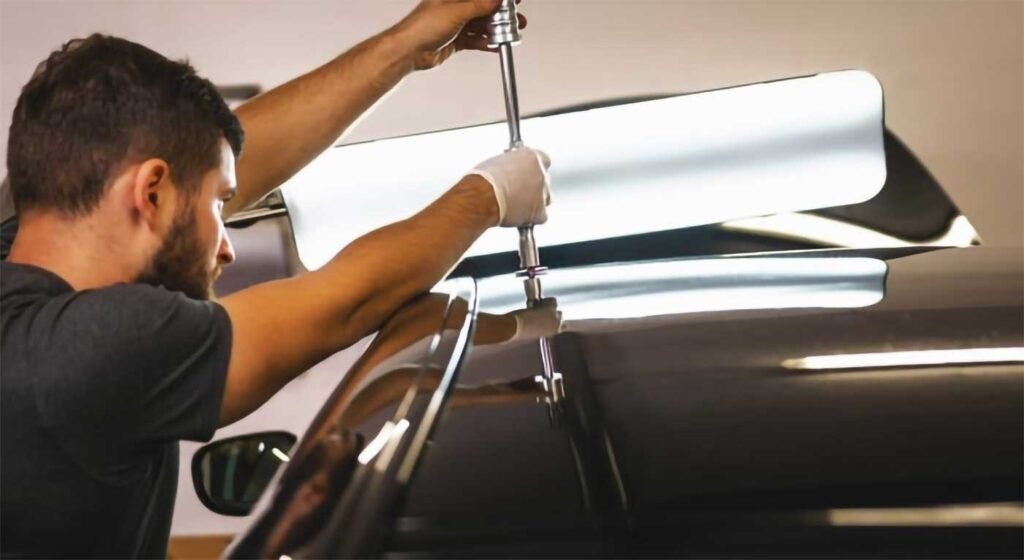Paintless Dent Repair (PDR) is a specialized technique used to remove minor dents and dings from vehicle panels without the need for repainting. While it may seem straightforward, professional PDR involves a deep understanding of metal properties, precision tool manipulation, and meticulous inspection techniques. In this article, we’ll dive into the step-by-step process of PDR, revealing the intricate skills behind achieving a flawless repair.
Step 1: Initial Assessment and Damage Evaluation
The process begins with a comprehensive assessment to determine the feasibility of PDR for the given damage. Not all dents are suitable for paintless repair — factors like dent size, location, and paint condition are carefully considered.
Inspecting the Dent: Technicians use specialized PDR lights and reflection boards to highlight the depth and edges of the dent.
Evaluating Access Points: Since PDR requires reaching behind the dent, access points are identified. This often involves removing interior panels, headlights, or taillights.
Assessing Paint Integrity: The technician ensures the paint hasn’t cracked. PDR is only viable when the original paint is intact.
Tools Used:
- PDR Inspection Lights
- Line/Fog Boards
- Paint Depth Gauge
Step 2: Gaining Access to the Dent
Once the assessment is complete, the next step is creating access to the damaged area. Technicians carefully disassemble necessary parts to reach the backside of the panel.
Tools Used:
- Trim Removal Tools
- Non-Marring Wedges
- Panel Clips and Fastener Tools
Step 3: Selecting the Right Tools
PDR employs an array of specialized tools designed for different types of dents and vehicle panels.
Push Rods: Long metal rods with various tips are used to push the dent from behind.
Whale Tails: Flat, curved tools ideal for tight spaces, especially inside door panels.
Glue Pulling Tools: For areas without backside access, glue tabs are applied to the panel’s exterior and pulled with a slide hammer or mini lifter.
Tool Selection Factors:
- Panel Material (Steel vs. Aluminum)
- Dent Size and Shape
- Accessibility
Step 4: Metal Manipulation and Dent Removal
This is the core of the PDR process — carefully massaging the metal back into its original shape.
Tool Positioning: The technician inserts the selected tool through the access point and aligns it beneath the dent.
Controlled Pushing: Using slow, controlled movements, the metal is gradually pushed outward. Each push is monitored using reflection patterns from PDR lights.
Blending Techniques: For high spots or raised areas, a blending hammer is used to tap the surface back down, ensuring a smooth finish.
Temperature Management: Aluminum panels require heat application during the process to prevent cracking due to their lower elasticity.
Tools and Techniques:
- Precision Push Rods
- Blending Hammers
- Heat Guns for Aluminum Panels
- Paintless Dent Repair | Paint Protection Film|Bumper Repair | TDB Automotive
- Service
Step 5: Quality Control and Final Inspection
Once the dent is removed, a meticulous quality check is conducted to ensure a perfect finish.
Final Light Inspection: Reflection boards or LED lights are repositioned to detect any remaining imperfections.
Surface Polishing: If necessary, the repaired area is polished to remove minor surface scratches or swirl marks.
Reassembling Components: Any removed panels or trims are carefully reinstalled, ensuring a factory-fit appearance.
Tools Used:
- Microfiber Cloths
- Polishing Compounds
- Inspection Lights
Step 6: Customer Walkthrough and Satisfaction Check
A professional PDR service always ends with a customer inspection and satisfaction check.
Explaining the Process: The technician walks the customer through the repair process.
Quality Assurance: The customer is invited to inspect the repaired area under proper lighting conditions.
Warranty and Care Tips: Many services offer a warranty and provide aftercare tips to maintain the vehicle’s pristine appearance.
Conclusion: Art Meets Science
Paintless Dent Repair is far more than just “pushing dents out.” It’s a blend of artistry, precision, and scientific understanding of metal memory. Each dent presents a unique challenge that requires skillful tool manipulation and keen attention to detail. Professional PDR ensures that a vehicle’s original factory finish is preserved while restoring its flawless appearance.
If you’re considering PDR, always opt for trained technicians who understand the nuances of this intricate craft. Mastery of these steps is what separates a true PDR artisan from the rest.
At TDB Automotive Service, we provide the best service to our customers.



